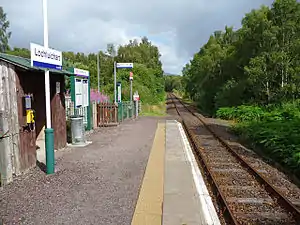Lochluichart railway station
Lochluichart railway station is a railway station on the Kyle of Lochalsh Line, serving the village of Lochluichart in the north of Scotland. The station is located at the north edge of Loch Luichart, 17 miles 20 chains (27.8 km) from Dingwall, between Garve and Achanalt.[4] ScotRail, who manage the station, operate all services.
 | |
| General information | |
| Location | Lochluichart, Highland Scotland |
| Coordinates | 57.6218°N 4.8091°W |
| Grid reference | NH323625 |
| Managed by | ScotRail |
| Platforms | 1 |
| Other information | |
| Station code | LCC[2] |
| History | |
| Original company | Dingwall and Skye Railway |
| Pre-grouping | Highland Railway |
| Post-grouping | LMS |
| Key dates | |
| 1 August 1871 | Opened as Lochluichart High[3] |
| 3 May 1954 | Resited and renamed as 'Lochluichart[3] |
| Passengers | |
| 2017/18 | |
| 2018/19 | |
| 2019/20 | |
| 2020/21 | |
| 2021/22 | |
| Notes | |
Passenger statistics from the Office of Rail and Road | |
History
The station was opened as Lochluichart High[3] by the Dingwall and Skye Railway on 1 August 1871 as a private station for Lady Ashburton on the Lochluichart Estate. It became a public station by 1887.[5]
In 1949 Lochluichart was planned to be relocated to allow the flooding of the area by the Glascarnoch-Luichart-Torr Achilty hydroelectric scheme.[6] On 3 May 1954 a new station was opened as Lochluichart[3] as a result of a hydro electric scheme raising the level of Loch Luichart, constructed of red sandstone. The deviation required about 2-mile (3.2 km) on stone-pitched embankments and in rock cuttings, a 100-foot (30 m) bridge over the River Conon and a 36-foot (11 m) bridge.[7]
Facilities
.jpg.webp)
Facilities are incredibly basic, comprising just a shelter, a help point and a small car park. The station is step-free.[8] As there are no facilities to purchase tickets, passengers must buy one in advance, or from the guard on the train.
Services
Four trains each way call (on request) on weekdays/Saturdays and one each way all year on Sundays, plus a second from May to late September only.[9][10]
| Preceding station | Following station | |||
|---|---|---|---|---|
| Garve | ScotRail Kyle of Lochalsh Line |
Achanalt | ||
| Historical railways | ||||
| Garve | Highland Railway Dingwall and Skye Railway |
Achanalt | ||
References
- Brailsford 2017, Gaelic/English Station Index.
- Deaves, Phil. "Railway Codes". railwaycodes.org.uk. Retrieved 27 September 2022.
- Butt (1995), page 147
- Bridge, Mike, ed. (2017). TRACKatlas of Mainland Britain: A Comprehensive Geographic Atlas Showing the Rail Network of Great Britain (3rd ed.). Sheffield: Platform 5 Publishing Ltd. p. 98. ISBN 978 1909431 26 3.
- Private and Untimetabled Railway Stations by G.Croughton page 96
- "A Station To Be Moved". Dundee Courier. Scotland. 6 May 1949. Retrieved 15 November 2017 – via British Newspaper Archive.
- Cooke, B.W.C., ed. (June 1954). "Re-Siting of Lochluichart Station". The Railway Magazine. Vol. 100, no. 638. Westminster: Tothill Press. p. 432.
- "National Rail Enquiries -". www.nationalrail.co.uk. Retrieved 23 August 2022.
- eNRT May 2022 Edition, Table 219
- eNRT December 2021 Edition, Table 219
Bibliography
- Brailsford, Martyn, ed. (December 2017) [1987]. Railway Track Diagrams 1: Scotland & Isle of Man (6th ed.). Frome: Trackmaps. ISBN 978-0-9549866-9-8.
- Butt, R. V. J. (October 1995). The Directory of Railway Stations: details every public and private passenger station, halt, platform and stopping place, past and present (1st ed.). Sparkford: Patrick Stephens Ltd. ISBN 978-1-85260-508-7. OCLC 60251199. OL 11956311M.
- Jowett, Alan (2000). Jowett's Nationalised Railway Atlas (1st ed.). Penryn, Cornwall: Atlantic Transport Publishers. ISBN 978-0-906899-99-1. OCLC 228266687.
- Jowett, Alan (March 1989). Jowett's Railway Atlas of Great Britain and Ireland: From Pre-Grouping to the Present Day (1st ed.). Sparkford: Patrick Stephens Ltd. ISBN 978-1-85260-086-0. OCLC 22311137.
External links
- "Lochluichart station on navigable O.S. map".
- "Dingwall and Skye Railway". RailScot. Retrieved 2 February 2011.